Bio 315 - Study guides, Class notes & Summaries
Looking for the best study guides, study notes and summaries about Bio 315? On this page you'll find 154 study documents about Bio 315.
All 154 results
Sort by
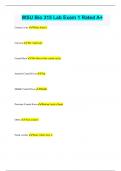
-
WSU Bio 315 Lab Exam 1 Rated A+
- Exam (elaborations) • 22 pages • 2024
-
Available in package deal
-
- $9.99
- + learn more
WSU Bio 315 Lab Exam 1 Rated A+ Cranial cavity Where brain is Calvaria The "skull cap" Cranial Base The floor of the cranial cavity Anterior Cranial Fossa Top Middle Cranial Fossa Middle Posterior Cranial Fossa Bottom, back of head Orbits "Eye sockets" Nasal cavities Space where nose is Bony nasal septum Line down center, divides Piriform aperture Piriform = pear shaped Outside/outline of nose Hard palate Roof of mouth, "brain freeze" Zygomatic arch Bon...
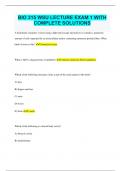
-
BIO 315 WSU LECTURE EXAM 1 WITH COMPLETE SOLUTIONS
- Exam (elaborations) • 28 pages • 2024
-
Available in package deal
-
- $9.99
- + learn more
BIO 315 WSU LECTURE EXAM 1 WITH COMPLETE SOLUTIONS A histologist examines a tissue using a light microscope and notices it contains a numerous amount of cells separated by an extracellular matrix containing numerous protein fibers. What kind of tissue is this? Connective tissue What is NOT a characteristic of epithelia? Contains numerous blood capillaries Which of the following structures is/are a part of the axial region of the body? A) legs B) fingers and toes C) arms D) wris...
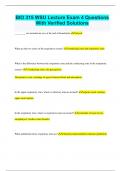
-
BIO 315 WSU Lecture Exam 4 Questions With Verified Solutions
- Exam (elaborations) • 35 pages • 2024
-
Available in package deal
-
- $10.99
- + learn more
BIO 315 WSU Lecture Exam 4 Questions With Verified Solutions _________ are terminal air sacs at the end of bronchioles Alveoli What are the two zones of the respiratory system? conducting zone and respiratory zone What is the difference between the respiratory zone and the conducting zone in the respiratory system? -Conducting zone: aire passageway -Respiratory zone: exchange of gases between blood and atmosphere In the upper respiratory tract, where is olfactory mucosa located?...
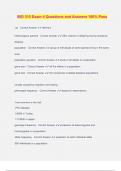
-
BIO 315 Exam 4 Questions and Answers 100% Pass
- Exam (elaborations) • 18 pages • 2024
-
- $12.49
- + learn more
BIO 315 Exam 4 Questions and Answers 100% Pass aa - Correct Answer ️️ -albinism heterozygous parents - Correct Answer ️️ -25% chance of offspring having recessive disease population - Correct Answer ️️ -group of individuals of same species living in the same area population genetics - Correct Answer ️️ -study of all alleles in a population gene pool - Correct Answer ️️ -all the alleles in a population gene flow - Correct Answer ️️ -the movement of alleles between ...
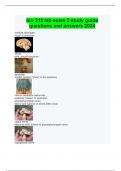
-
bio 315 lab exam 2 study guide questions and answers 2024
- Exam (elaborations) • 34 pages • 2024
-
Available in package deal
-
- $15.99
- + learn more
medulla oblongata "legs" of seahorse olives pink, smooth structure pyramids medial, anterior "shins" of the seahorse inferior cerebellar peduncles posterior "calves" of seahorse glossopharyngeal nerve lateral and superior to olives (little circle) vagus nerve lateral to olive, inferior to glossopharyngeal nerve hypoglossal nerve longer (hotdog bun), medial to olive spinal accessory nerve 2 v-shapes on sides of "legs" Pons "belly" of the seahorse ...
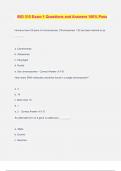
-
BIO 315 Exam 1 Questions and Answers 100% Pass
- Exam (elaborations) • 17 pages • 2024
- Available in package deal
-
- $12.49
- + learn more
BIO 315 Exam 1 Questions and Answers 100% Pass Humans have 23 pairs of chromosomes. Chromosomes 1-22 are best referred to as ______. a. Centromeres b. Autosomes c. Karyotype d. Nuclei e. Sex chromosomes - Correct Answer ️️ -B How many DNA molecules would be found in a single chromosome? a. 4 b. 10 c. More than 10 d. 1 e. 2 - Correct Answer ️️ -D An alternate form of a gene is called a(n) ________. a. Allele b. Exome c. Genome d. Chromosomes e. mutation - Correct Answer...
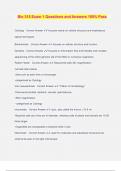
-
Bio 315 Exam 1 Questions and Answers 100% Pass
- Exam (elaborations) • 14 pages • 2024
-
- $12.49
- + learn more
Bio 315 Exam 1 Questions and Answers 100% Pass Cytology - Correct Answer ️️ -focuses mainly on cellular structure and emphasizes optical techniques Biochemistry - Correct Answer ️️ -focuses on cellular structure and function Genetics - Correct Answer ️️ -focuses on information flow and heredity and includes sequencing of the entire genome (all of the DNA) in numerous organisms Robert Hooke - Correct Answer ️️ -Discovered cells 30x magnification -termed cells Cellula -drew...
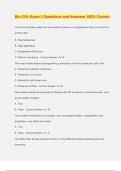
-
Bio 315- Exam 1 Questions and Answers 100% Correct
- Exam (elaborations) • 14 pages • 2024
-
- $12.49
- + learn more
Bio 315- Exam 1 Questions and Answers 100% Correct From the list below, select the one cellular structure or compartment that is not found in animal cells: A. Plasmodesmata B. Golgi apparatus C. Endoplasmic Reticulum D. Plasma membrane - Correct Answer ️️ -A The most reliable feature distinguishing a eukaryotic cell from prokaryotic cell is the: A. Presence of plasma membrane B. Presence of a nucleus C. Eukaryotic cells larger size D. Presence of DNA - Correct Answer ️️ -B No...
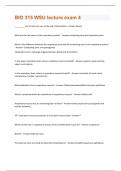
-
BIO 315 WSU lecture exam 4 Questions And Answers!!
- Exam (elaborations) • 21 pages • 2024
- Available in package deal
-
- $7.99
- + learn more
_________ are terminal air sacs at the end of bronchioles - Answer-Alveoli What are the two zones of the respiratory system? - Answer-conducting zone and respiratory zone What is the difference between the respiratory zone and the conducting zone in the respiratory system? - Answer--Conducting zone: aire passageway -Respiratory zone: exchange of gases between blood and atmosphere In the upper respiratory tract, where is olfactory mucosa located? - Answer-superior nasal conchae, upper nasal...
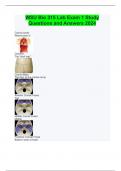
-
WSU Bio 315 Lab Exam 1 Study Questions and Answers 2024
- Exam (elaborations) • 27 pages • 2024
-
Available in package deal
-
- $14.49
- + learn more
Cranial cavity Where brain is Calvaria The "skull cap" Cranial Base The floor of the cranial cavity Anterior Cranial Fossa Top Middle Cranial Fossa Middle Posterior Cranial Fossa Bottom, back of head Orbits "Eye sockets" Nasal cavities Space where nose is Bony nasal septum Line down center, divides Piriform aperture Piriform = pear shaped Outside/outline of nose Hard palate Roof of mouth, "brain freeze" Zygomatic arch Bone in cheek ...

Did you know that on average a seller on Stuvia earns $82 per month selling study resources? Hmm, hint, hint. Discover all about earning on Stuvia


